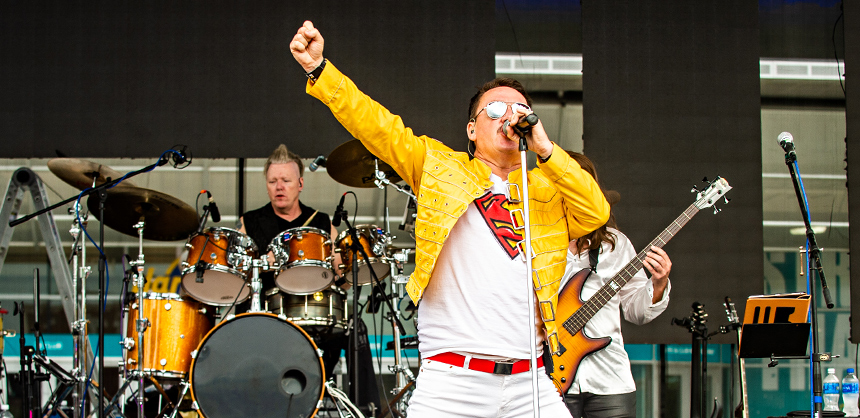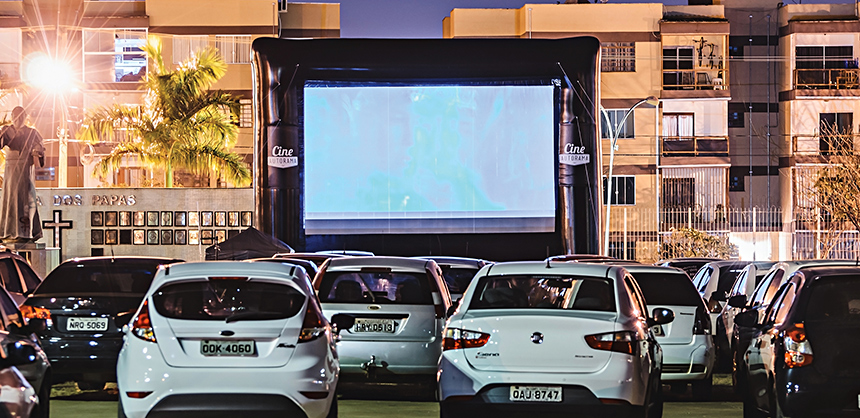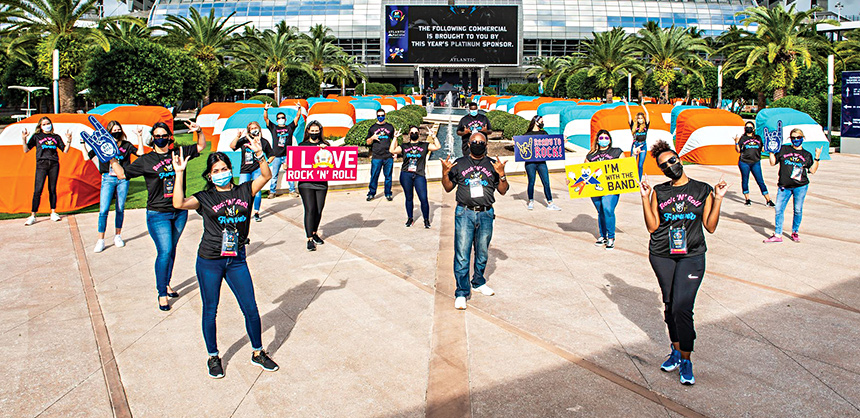Drive TimeFebruary 15, 2021
Attendees Don’t Have To Fly When They Can Get Behind The Wheel By Maura KellerDrive Time
Attendees Don’t Have To Fly When They Can Get Behind The Wheel
Martyn Jenkins, of Absolute Queen, performs at Hard Rock Stadium in Miami Gardens, Florida, for AP ROCKS attendees. Victoria Genova Photography / Courtesy of Lisa Pierce Events
With COVID-19 impacting people’s ability to travel to meetings and events, more planners are orchestrating “drive-in” meetings — local or regional gatherings that are geared toward attendees who reside within driving distance of the event. So what do these meetings entail, and what do planners need to consider when planning drive-in meetings?
Regionally Focused
Until we have full roll-out of the vaccine, businesses will continue to be reluctant to send employees off on “non-essential” travel, such as attending events. To combat this, Liz Lathan, CMP, CEO of Haute Dokimazo, thinks the meetings and events industry will see more distributed activities that will connect nationwide. Even global participants can tune in via online content syndicated across multiple venues. All of Haute Dokimazo’s drive-in experiences they have created so far have been largely hospitality or planning meetings. “We are lucky to have an indoor/outdoor venue, so we can hold meetings with the garage doors rolled open and let the participants freely move in and out of the space,” Lathan says. “We have also run a number of drive-in concerts in our concert field that have been very successful. Each attendee gets two large parking spots — one for their car and one to bring lawn chairs — and they get to enjoy the concert with food and drink delivery to their parking spot.”
Keith Willard, president of Keith Willard Events, says the first thing meeting planners need to consider is space. If you have 20 vehicles or 300 vehicles, the amount of space needed will be dramatically different. “You will also need to include traffic issues,” Willard says. “Since most events have a fairly specific start time, you will need to account for a line of cars even if you have a truly efficient entrance.”
For potential attendees, the appealing aspects of drive-in meetings include that these meetings are more cost- and time-effective compared to airfare for the attendee or host who is paying. What’s more, during the pandemic, it can be safer to drive your own car and avoid large crowds in airports or train stations. In addition, each attendee has more control over when they arrive and depart. If the meeting ends early, they can depart without worrying about changing a plane/train ticket.
Weather also is always the variable that provides the most stress for drive-in meetings. Time of year is ultimately important, since you want to hedge your bets on conditions that allow for guests to avoid snowstorms, arctic temperatures, or tropical storms that may impede their ability to drive safely to the meeting destination.
Caytie Pohlen-LaClare, meeting planner and owner/president of The LaClare Group Inc., recommends meeting planners consider the start/end times of a drive-in event to allow people to drive at reasonable times of day, including avoiding rush hour and late-night driving. “We had a client whose audience was mostly from outside the metro area, and they were not familiar with the city center. They were intimidated at the thought of driving into the city with lots of traffic and one-way streets,” Pohlen-LaClare says. “This had a negative effect on attendance.” In another situation, a Minnesota client’s event was scheduled for 3 p.m. in late winter. “Unfortunately, a snowstorm started the morning of the event and the roads got worse throughout the day,” Pohlen-LaClare says. “The majority of their attendees stayed home because the driving conditions were bad.”
Indeed, Jennifer D. Collins, CMP DES, president and CEO at JDC Events, agrees that one of the downsides of this model is weather. “So, as with all events planned, there needs to be backup considerations,” Collins says.
Attendees also need to know what safety measures are in place, so consider mailing a logo mask to all who register or give to them on-site at registration. “I also like the idea of providing logo gloves for those who would want that extra bit of safety or their own water bottle,” says Marla Harr, business consultant, meetings & events at Business Etiquette International. “You also want to provide examples of room set-ups on the event website. Planners need to create new, less-crowded room sets.”

Campo Grande, Brazil – August 16, 2018: Parked cars at Praca do Papa square to watch movies inside the car. Cine Autorama event, drive-in, open air cinema, open to public.
If You Host It, They Will Come
As the director of VIBE Agency, an event design and destination management company in Miami, Florida, Valerie Bihet stresses that, when planning a drive-in event, you should remember that people in the United States like to drive, so planners can expect some attendees to drive as far as four to six hours to attend. “It should definitely be more than two hours because that really isn’t that far and people regularly are doing that on their own for fun,” Bihet says. “If you make your meeting destination four to six hours away then it will be a real change of scenery for work purposes.”
You should give attendees something to do along the way to keep them engaged and excited about arriving. For example, Bihet suggests preparing a music playlist for them to listen to along the way so everyone at the company has the same music to set the tone. And it can be a conversation starter when they arrive on-site. “You can also have them do an activity at various stops along the way, like take a picture somewhere specific, buy something from a local shop or have them do a challenge,” Bihet says. “Then, when they arrive that night, you showcase it all for everyone to see what they did or earn points at various stops and win an award.”
Bihet recently orchestrated an incentive trip where the VIBE Agency team rented more than 100 convertible cars for the attendees to drive from Miami to the hotel in Key West to make the trip more fun. “We did some special stops and they had to try a [beverage] at one spot, one to take a photo in another, and then they got to see how each other did when they arrived,” Bihet says. “They really had fun with it.”

Lisa Pierce, of Lisa Pierce Events, says her drive-in event was a huge success because its rock ‘n’ roll theme was appealing to attendees. Victoria Genova Photography / Courtesy of Lisa Pierce Events
Pohlen-LaClare suggests considering where attendees are located and finding a fun location or venue that is easy to reach, centrally located for majority of participants, and possibly in the opposite direction of traffic. An example would be to go to a nearby small town or outer ring suburb instead of into a major city. “Nature and spending time outdoors also are more appealing to people now so consider a location next to a river, lake or ocean, in a beautiful forest or in the mountains,” she says.
At a recent dinner event in a downtown location, The LaClare Group chose a unique venue that had major appeal to the local attendees. They provided complimentary valet parking and made sure to publicize that fact in all pre-meeting communications. “And for a statewide group’s multi-day meeting, we chose a venue on the outer edge of the metro area,” Pohlen-LaClare says. “There was plenty of free, surface parking and no traffic hassles. This venue was near a variety of restaurants which allowed participants the convenience and flexibility to leave the meeting venue and dine within their budget.”
Lathan stresses that there are certainly cost considerations with drive-in meetings. The A/V needs and changes in how planners manage F&B are key considerations. In addition, meeting spaces must adhere to social distancing guidelines, which may require microphones for each participant in an interactive conversation-based session. Other A/V cost considerations include needing to rent larger or more screens for participants to view from farther away. “It’s imperative when meeting planners are mapping out the experience that they truly optimize for what needs to happen in-person rather than virtually,” Lathan says. “Focus on tactile and networking activities that benefit from people being together, but beware of alcohol and food-driven gatherings that require people to remove masks in order to participate.”
Lathan’s favorite way of organizing a drive-in event that has a hybrid component is to make the in-person portion attractive by setting the content up like a TV show and making the in-person audience who drove to the event feel like they are at a live taping or in a live broadcast studio audience. “This makes the content optimized for a digital audience — meaning they feel like it was made for them to watch at home, while giving the in-person attendees a special experience that they can only get in-person,” Lathan says. “It also helps the small, intimate gatherings feel purposeful, and not like outside forces made it limited.”
To create an informative, enticing, yet fun drive-to event, Lisa Pierce, event planner and “stress reliever” at Lisa Pierce Events, recommends creating a theme for the meeting or event to make it something people want to attend. “Create excitement with teaser videos or emails. Let attendees know you will also be following best practices for COVID-19 safety,” Pierce says. “This will boost attendee confidence. Keep the content informative and motivational. Bring in a great motivational speaker who really fits with the event’s mission statement or a band. Do something different and unexpected. This is 2021, we need to feel positive and have a renewed human connection.”
Pierce orchestrated a very successful corporate meeting late last year at Hard Rock Stadium in Miami Gardens, Florida with more than 160 attendees. They drove in from all over Florida, and they had attendees from Texas, California and Georgia attend virtually. “We planned events in their area at safe locations. Everything was branded the same to be cohesive and we gave them experiences as well,” Pierce says.
The theme at the AP ROCKS event was a rock ’n’ roll concert, and Pierce branded everything — the company logos, swag, their mascot, agendas, signs made for physical distancing, check-in, will-call, etc. “Attendees were in their own cabanas set 6 feet apart. All the individual rock ’n’ roll swag was pre-set in their cabanas following safety protocol,” Pierce says. To get attendees excited and eager to attend, Pierce had teaser videos, fun emails and let everyone know to come dressed in their favorite concert T-shirt. These teasers continued up to the day of the event to create excitement. “The moment attendees entered they were at their concert. Then attendees proceeded to will-call where they received individual lanyards with their concert ticket seating/preset,” Pierce says. They had the Absolute Queen tribute band, which also morphed into doing AC/DC, and had Triple P Entertainment as an emcee and DJ. “At the end of the meeting, attendees were invited to an outdoor movie experience in their cabanas. This event was magical,” she adds.

Photo Courtesy of Keith Willard Events
On the Horizon
While COVID still impacts the meeting and events environment, resulting in more drive-in meetings, meeting professionals agree that drive-in meetings are not going to replace long-distance meetings anytime soon. “I don’t think they will stick around. In the U.S., people love to fly more than they drive, so when that is safe again, I think these will go away,” Bihet says. “There may be some companies where people are not comfortable flying for much longer, but in general, I think these will only be a big option for the next year or so. Then in 2022, people will fly again for work.”
However, a drive-in daytime event for a company locally could still work long term. “You don’t have to go further away for driving-related events to still be fun,” Bihet says.
For Collins, these types of experiences will be options to consider going forward — similar to digital events. “I believe our public health crisis is forcing meeting planners to consider an ‘all hands on deck’ model to become more creative in designing experiences, which is actually a great by-product,” Collins says.
Pohlen-LaClare thinks drive-in/drive-to meetings are here to stay. And really, those types of meetings have been a reality for decades, especially for state and local groups. “We already have clients who are re-thinking their one, big national meeting, and breaking it down to several regional meetings,” Pohlen-LaClare says. “I think we will see an increase in drive-to meetings in the future. Where and how we work has changed and is changing, which also means where and how we meet will also change.”
Lathan thinks drive-to meetings have a place during the pandemic. “I think they will be a necessity for 2021, but I think they are incredibly cost-prohibitive when attempting to scale,” Lathan says. “We’ll see many more small group gatherings in person this year, but the investment needed to do many small gatherings around the globe will prove not sustainable once we feel comfortable traveling freely again.”
One thing upon which everyone can agree is that meeting planners will need to modify their planning to have greater consideration of how attendees travel to meetings, as driving will be an increasingly common mode of transportation. Planners will always succeed when they put themselves in the “driver’s seat” and think about what they would want/need if they were driving to a meeting. “Don’t let your guard down and assume that local meetings are less work. The additional driving details must be considered to be the most effective for all attendees,” Pohlen-LaClare says. “To successfully plan your meetings and events, you need to focus on your attendees.”
Harr agrees. She suggests getting to know the attendees, perhaps by conducting a survey in advance to see what is important to them, then make adjustments. “Meetings are always about the attendees. The No. 1 responsibility of a meeting professional is the safety and security of their attendees, which has taken on a new meaning in 2021,” Harr says. “Also, find out what your speakers or presenters will require for them to show up. You may have to do a mix of in-person or use of technology to present from a remote location. In this case, the technology has to be almost perfect.”
Business professionals — and humans in general — are desperate to reconnect. Lathan stresses that meeting planners have an opportunity to get people out of their rut of daily remote life and into a memorable moment that will drive relationships in 2021. “Plan your locations strategically to maximize high-impact target customers, and don’t try to replicate the old way of doing things in a larger space,” Lathan says. “Think through the uniqueness and special reasons why people gather, and plan around that. Increase your budgets for this year, and be ready to enforce mask-wearing. It will be a challenge, but we’re all eager to take it on. Let’s get back to meeting . . . safely.” C&IT








